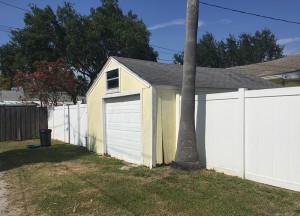
The garage was built in 1938, and deterioration has made it unusable.
By BRIGITTA A. SHOUPPE
USFSP Reporter
GULFPORT – When artist Margo Dalgetty moved from Maryland to Gulfport in October, she had dreams of buying her forever home with a studio where her work would be inspired by a touch of Florida sunshine.
Instead, on April 13 she found herself waiting for Gulfport’s five-member Board of Adjustment to rule on her variance request to see whether she would have the garage and studio of her dreams.
An artist for 25 years, Dalgetty sells her work at Mermaid Bay Mercantile Co. in downtown Gulfport. While she has made refurbished housewares, mixed media and other things, she says her bread and butter is polymer clay jewelry.
The Board of Adjustment meets the second Wednesday of each month. Its five members are appointed by the City Council, work for free and have the power to hear and decide on appeals from administrative decisions and variances to zoning requirements.
When it comes to special exceptions and building projects, the only higher authority in Gulfport is an appeals process to the City Council.
“I really didn’t know what to expect, but it was an interesting process,” Dalgetty said after the meeting.
Her hope was to tear down an aging garage and rebuild with a second story artists’ studio. Designs called for the garage to be 10.25 feet from the alleyway despite zoning requirements for rear-yard setbacks of 25 feet.
“The current garage on the property sits even back further than the variance request,” said David Lance of Lanco Construction. “Unfortunately, the garage is in disrepair and needs to be rebuilt, and there is nowhere else on the property that is functional.”
Surprising Lance, the board jumped over the setback issue and honed in on the plans for a full bathroom and large sink in the living space.
“The plans look like you’re building an apartment, not an artist studio. You’ve got a full bathroom with a tub in the proposed drawings,” said vice chairman William Seawall.
The drawings also show a second large utility sink in the main living area. That would make it just an electric stove installation shy of becoming a functional kitchen and an unregistered illegal rental unit.
By law, a living unit has a living space, a sleeping space and a kitchen. The kitchen does not have to have a full working stovetop and oven. Any sort of cooktop type surface will suffice.
While a rental unit helps homeowners offset the cost of their mortgage, neighborhoods with high percentages of renters are often associated with lower property values.
According to the Pinellas property appraiser’s records, less than half of Gulfport’s residential properties are registered as the owners’ primary homestead. This does not mean that all of the remaining properties are rentals; some may be vacation homes, for example.
However, with such a high percentage of non-homeowners Gulfport residents might be leery of policies that increase the overall number of rental units in town.
Dalgetty testified to reiterate her wishes to use the space to work, not as a living unit. With a legal duplex on the property, she said, if she ever did decide to take on a renter, that is the space she would rent.
“I am not looking to recreate a living space. The reason I wanted the sink was to wash my brushes,” she said.
“It’s not that we think you are going to misuse the space,” said board member Art Padule. “It’s the people who come after you. You see, we’ve had these issues in the past.”
One member recalled a resident who requested a similar exception. She started using the space as an unregistered rental unit a year and a half after receiving the Board of Adjustment’s blessing. City officials didn’t find out about the violation for another eight years.
When the city does detect a violation, however, the punishment is significant. The city can fine residents up to $250 per day for each day the violation exists. That charge is upped to $500 per day for continued or second-time violators.
Despite a rocky start, after 30 minutes of discussion Padula moved to approve the drawing as presented, with the stipulation that it is never to be used as a dwelling unit.
The motion passed 5-0. With that, Dalgetty was one step closer to building the studio of her dreams.
